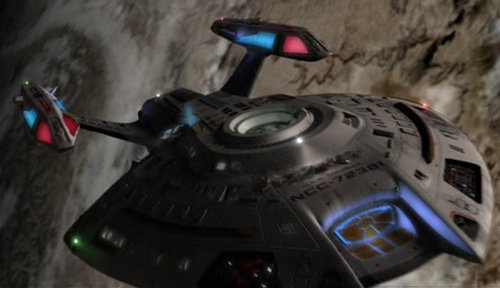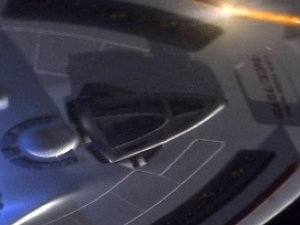Nova class
| Date entered service | 2368 |
| Length | 185m |
| Width | 81m |
| Height | 31m |
| Transporters | • Personnel: 3 • Emergency: 3 |
| Crew | 80 |
| Shuttlecraft | 5 |
| Speed | • Cruising: Warp 6 • Max Safe: Warp 7 Emergency: Warp 8 |
| Weapons | • Type X Phaser arrays • 1 torpedo tube • photon torpedoes |
| Advertising |
A short-range research vessel, the Nova class furthered Starfleet's mission of scientific discovery. The successor to the long-lived Oberth class, the Nova class engaged in limited duration planetary and system surveys, freeing up other starships for further long-range exploration. Extensive sensor pallets and landing capabilities complemented extensive laboratory facilities aboard, allowing the performance of detailed research, analysis, and assessment. While limited in speed and armament, the class was exceptionally durable, making it reliable in adverse conditions.[1]
The Nova class built upon the role of the deep space surveyor in many ways. Unlike the Oberth class, the Nova class contained more advanced scientific facilities and finely-tuned sensors, allowing it to perform more research in a shorter period of time. The capability of atmospheric entry allowed the class the ability to land when necessary for extended surveys. Additionally, the ship's rugged durability was a far cry from the vulnerability of its Oberth class predecessors, which were lost with alarming frequency.[1]
When Starfleet engineers began working on a replacement for the Oberth class, they turned to developments made during the Defiant Class Development Project. The spaceframe was originally contracted by the Advanced Starship Design Bureau (ASDB) for the Defiant Project and was put through numerous warp field simulations and structural testing phases, though, ultimately, Starfleet engineers chose an alternate spaceframe for the Defiant class. With a spare, and proven, structural design, the Defiant Pathfinder spaceframe was selected as the foundation for the Nova class. A number of significant design alterations were made, namely the removal of several torpedo launchers and the addition of refined sensor arrays.[1]
The Nova class, however, almost did not come to pass. Early on in the program, one of the first vessels launched, the U.S.S. Equinox NCC-72381, vanished near the Badlands. The unexplained loss of the ship so early in its operational lifetime prompted a suspension of continued production and a top-down review of the entire program. A detailed analysis of the U.S.S. Nova NX-72330, the design plans, test flight data, individual components, and assembly procedures revealed no discernable flaws, and Starfleet Command reinstituted construction. It would be several years before Starfleet learned what had happened to the Equinox; once the U.S.S. Voyager NCC-74656 was contacted via the Pathfinder Project, it was discovered that the Equinox had also been pulled into the Delta Quadrant and had survived far beyond its design parameters.[1]
Although not the most comfortable posting due to the ship's small size, feedback from officers and crews assigned to Nova class scouts was favorable. Other Nova class ships didn't experience the rigors to which the Equinox had been subjected, but performed exceedingly well, and by 2377 were on track to replace the Oberth class as those ships were retired.[1]
The most visually distinctive feature of the Nova class was the large sensor array forward of the primary hull, which housed a Class 4 sensor suite and integrated with the ship's multiple dorsal and ventral sensor pallets. Foremost, the Nova class was a scientific research and sensor platform, and the design reflected this.[1]
The Nova class spaceframe, a holdover from the Defiant Project, was streamlined for atmospheric entry and landing capability. Although not a routine maneuver, this capacity extended the class' operational alternatives and provided the crew with the option of using the ship as a planetary research base.[1]
Another feature that extended the ship's research capabilities was the inclusion of the Waverider class atmospheric operations shuttlecraft, stored on the ventral side of the primary hull, much like the Captain's Yacht aboard Galaxy and Sovereign class cruisers, or the Aeroshuttle aboard the Intrepid (II) class. The Waverider was Starfleet's most advanced atmospheric craft and allowed Nova class ships to extend their exploratory ventures over a greater area. An aft shuttlebay held several auxiliary craft, typically standard shuttlecraft and Work bee general utility craft.[1]
The LF-47 warp engine provided ample poer distribution to various systems, but limited the class to a maximum speed of Warp 8, with an effective cruising speed of Warp 6. While not designed to withstand extended combat, the Nova class possessed the capacity to defend itself should the need arise. In case of conflict, the class was adequately armed with Type X Phaser arrays and the latest Mark 95 direct-fire torpedo launcher, which was capable of firing both Photon and Quantum torpedoes, as well as advanced sensor probes. Because of the class' tight streamlining and limited internal space, torpedo loadout remained limited to 20 photon torpedoes under typical circumstances. Its compact design also limited the amount of consumables carried, providing the class with a maximum standard mission profile of two years.[1]
Nova class vessels
Prime Timeline
U.S.S. Equinox NCC-72381 • U.S.S. Nova NCC-73515 • U.S.S. Rhode Island NCC-72701
LUG Timeline
U.S.S. Aurora NCC-72321 • U.S.S. Binary NCC-72454 • U.S.S. Freeman Dyson NCC-72411 • U.S.S. Equinox NCC-72381 • U.S.S. Nova NX-72330 • U.S.S. Pulsar NCC-72358 • U.S.S. Quasar NCC-72369 • U.S.S. Rhode Island NCC-72701 • U.S.S. Solstice NCC-72409
STO Timeline
U.S.S. Equinox NCC-72381 • U.S.S. Rhode Island NCC-72701
V271 Timeline
Notes and References
- ↑ Jump up to: 1.0 1.1 1.2 1.3 1.4 1.5 1.6 1.7 1.8 Heinig, Jess Ross A. Isaacs (Line Developers). Starships. Star Trek Roleplaying Game. Book 4. Written by Bill Bridges, Andrew Greenberg, Kenneth Hite, Ross A. Isaacs, and Doug Sun. Illustrations by David Pipgras. Decipher, Inc.. 2003.


